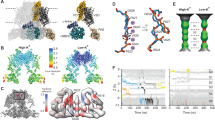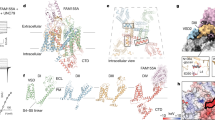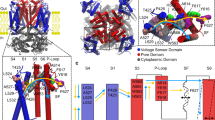Abstract
A HUMAN genetic defect associated with 'long Q–T syndrome', an abnormality of cardiac rhythm involving the repolarization of the action potential, was recently found to lie in the HERG gene, which codes for a potassium channel1. The HERG K+ channel is unusual in that it seems to have the architectural plan of the depolarization-activated K+ channel family (six putative trans-membrane segments), yet it exhibits rectification like that of the inward-rectifying K+ channels, a family with different molecular structure (two transmembrane segments)2–4. We have studied HERG channels expressed in mammalian cells and find that this inward rectification arises from a rapid and voltage-dependent inactivation process that reduces conductance at positive voltages. The inactivation gating mechanism resembles that of C-type inactivation, often considered to be the Slow inactivation' mechanism of other K+ channels. The characteristics of this gating suggest a specific role for this channel in the normal suppression of arrhythmias.
This is a preview of subscription content, access via your institution
Access options
Subscribe to this journal
Receive 51 print issues and online access
$199.00 per year
only $3.90 per issue
Buy this article
- Purchase on SpringerLink
- Instant access to full article PDF
Prices may be subject to local taxes which are calculated during checkout
Similar content being viewed by others
References
Curran, M. E. et al. Cell 80, 795–803 (1995).
Warmke, J. W. & Ganetzky, B. Proc. natn. Acad. Sci. U.S.A. 91, 3438–3442 (1994).
Sanguinetti, M. C., Jiang, C., Curran, M. E. & Keating, M. T. Cell 81, 299–307 (1995).
Trudeau, M. C., Warmke, J. W., Ganetzky, B. & Robertson, G. A. Science 269, 92–95 (1995).
Sanguinetti, M. C. & Jurkiewicz, N. K. J. gen. Physiol. 96, 195–215 (1990).
Shibasaki, T. J. Physiol., Lond. 387, 227–250 (1987).
Vandenberg, C. A. Proc. natn. Acad. Sci. U.S.A. 84, 2560–2564 (1987).
Lu, Z. & MacKinnon, R. Nature 371, 243–246 (1994).
Nichols, C. G., Ho, K. & Hebert, S. J. Physiol., Lond. 476, 399–409 (1994).
Stanfield, P. R. et al. J. Physiol., Lond. 475, 1–7 (1994).
Hoshi, T., Zagotta, W. N. & Aldrich, R. W. Science 250, 533–538 (1990).
Zagotta, W. N., Hoshi, T. & Aldrich, R. W. Science 250, 568–571 (1990).
Demo, S. D. & Yellen, G. Neuron 7, 743–753 (1991).
Hoshi, T., Zagotta, W. N. & Aldrich, R. W. Neuron 7, 547–556 (1991).
Choi, K. L., Aldrich, R. W. & Yellen, G. Proc. natn. Acad. Sci. U.S.A. 88, 5092–5095 (1991).
Yellen, G., Sodickson, D., Chen, T.-Y. & Jurman, M. E. Biophys. J. 66, 1068–1075 (1994).
Anderson, J. A., Huprikar, S. S., Kochian, L. V., Lucas, W. J. & Gaber, R. F. Proc. natn. Acad. Sci. U.S.A. 89, 3736–3740 (1992).
Cao, Y., Crawford, N. M. & Schroeder, J. I. J. biol. Chem. 270, 17697–17701 (1995).
Hoshi, T. J. gen. Physiol. 105, 309–328 (1995).
Löpez-Barneo, J., Hoshi, T., Heinemann, S. H. & Aldrich, R. W. Recept. Chan. 1, 61–71 (1993).
Heginbotham, L., Lu, Z., Abramson, T. & MacKinnon, R. Biophys. J 66, 1061–1067 (1994).
Baukrowitz, T. & Yellen, G. Neuron 15, 951–960 (1995).
Baukrowitz, T. & Yellen, G. Science 271, 653–656 (1996).
Jurman, M. E., Boland, L. M., Liu, Y. & Yellen, G. BioTechniques 17, 876–881 (1994).
Author information
Authors and Affiliations
Rights and permissions
About this article
Cite this article
Smith, P., Baukrowitz, T. & Yellen, G. The inward rectification mechanism of the HERG cardiac potassium channel. Nature 379, 833–836 (1996). https://doi.org/10.1038/379833a0
Received:
Accepted:
Issue Date:
DOI: https://doi.org/10.1038/379833a0
This article is cited by
-
Noncanonical electromechanical coupling paths in cardiac hERG potassium channel
Nature Communications (2023)
-
Identification of undecylenic acid as EAG channel inhibitor using surface plasmon resonance-based screen of KCNH channels
BMC Pharmacology and Toxicology (2019)
-
Prevailing Effects of Ibutilide on Fast Delayed Rectifier K+ Channel
The Journal of Membrane Biology (2019)
-
Gating mechanism of Kv11.1 (hERG) K+ channels without covalent connection between voltage sensor and pore domains
Pflügers Archiv - European Journal of Physiology (2018)



